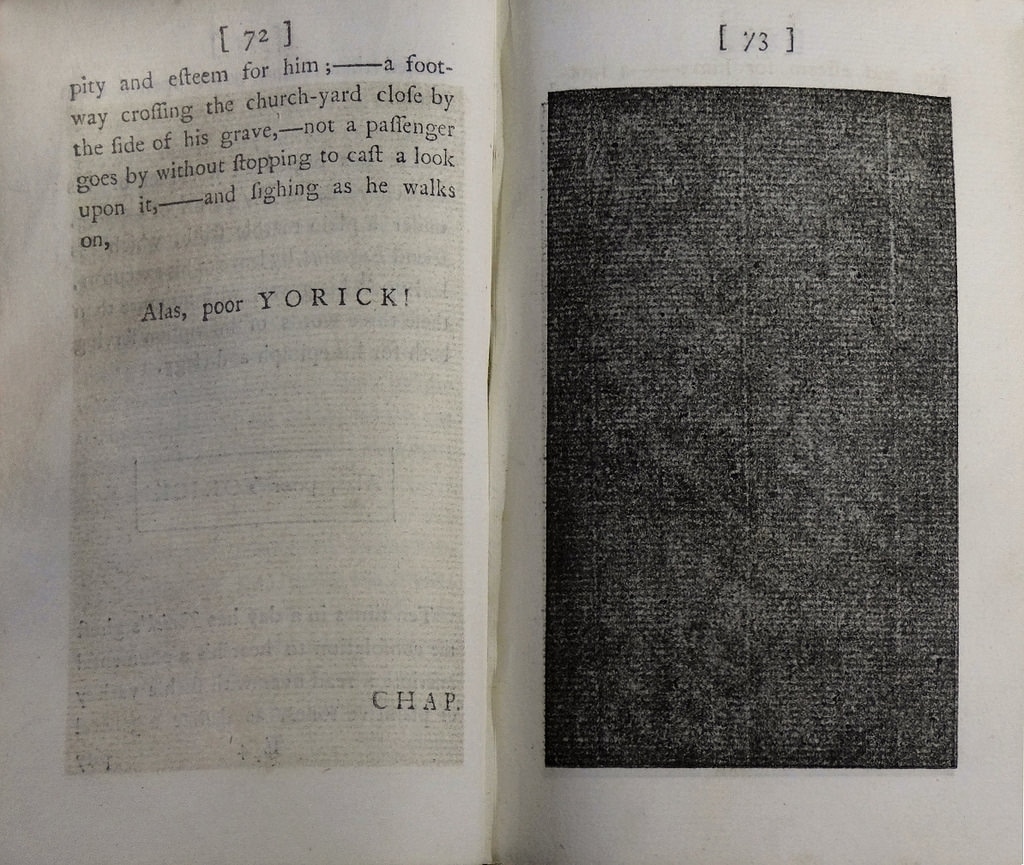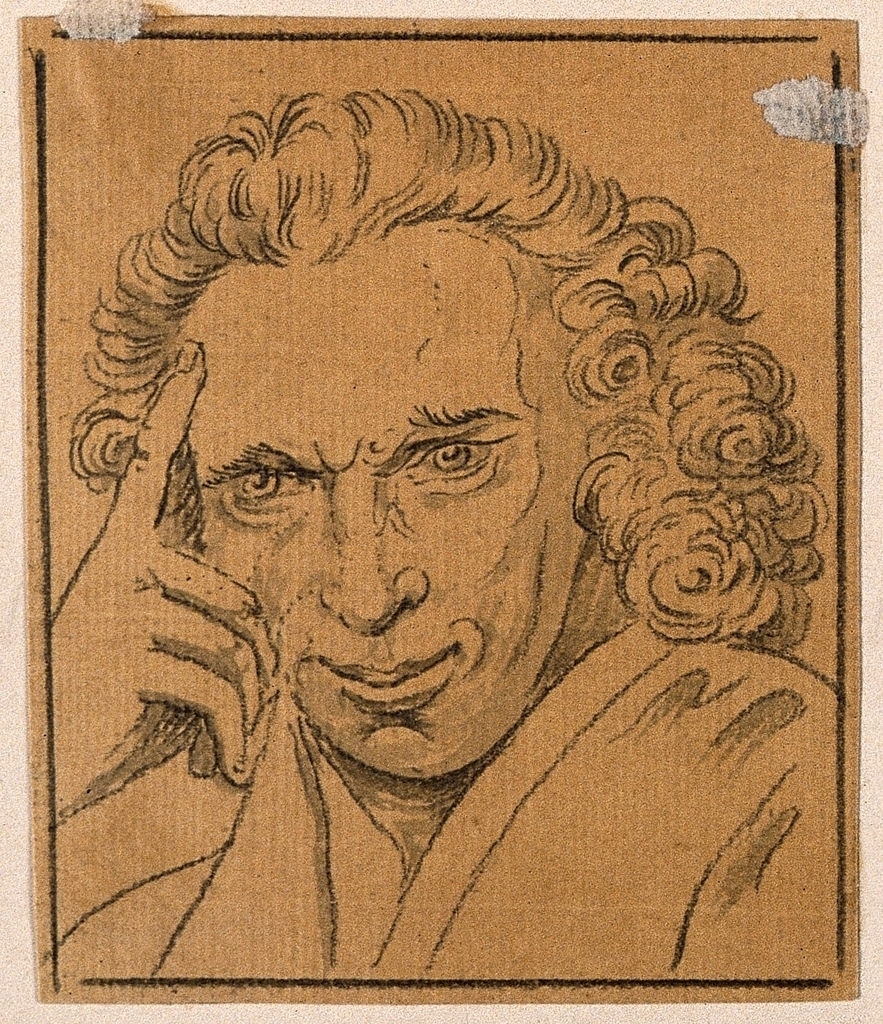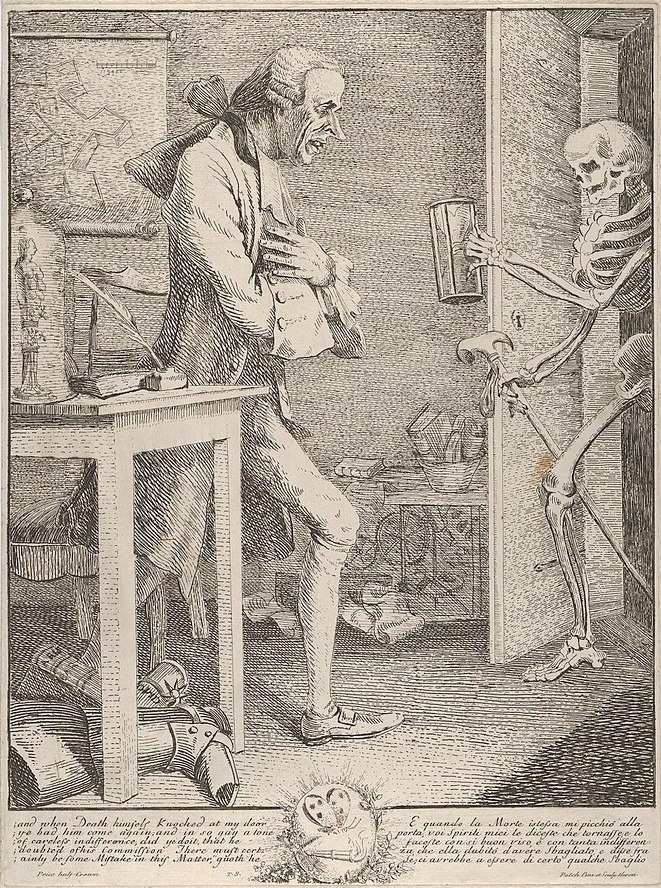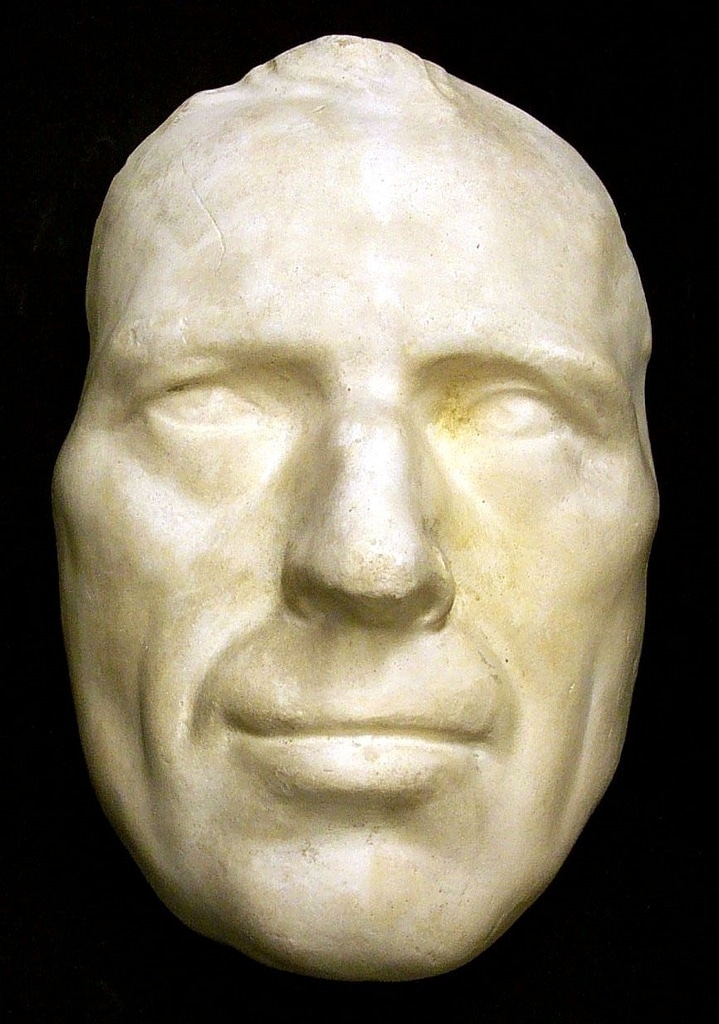This essay was originally published in The Public Domain Review under a Creative Commons License. Please see their rules for reuse.
On the 250th anniversary of Laurence Sterne’s death, Ian Campbell Ross looks at the engagement with mortality so important to the novelist’s groundbreaking work.

This year brings two notable anniversaries in the life of the Reverend Laurence Sterne, author of The Life and Opinions of Tristram Shandy, Gentleman. Two hundred fifty years ago, on February 27, 1768, he published A Sentimental Journey through France and Italy. By Mr. Yorick. Fewer than three weeks later, on March 18, aged just fifty-four, he died.
Few writers have passed their entire literary career so knowingly in the shadow of death as had Sterne. In the work of still fewer, least of all eighteenth-century comic novelists, does death appear so prominently or so pervasively. In the first of Tristram Shandy’s nine volumes, published in five instalments between 1759 and 1767, Parson Yorick, a fictionalised self-portrait of the author, dies. Three words are inscribed upon the plain marble slab that marks his grave, serving — as passers-by observe it — as both epitaph and elegy: “Alas, poor YORICK!” In Sterne’s novel, these all-too-familiar words face a wholly unfamiliar black leaf: a gesture towards the impenetrability of death that anticipates the many ingenuities that mark out Tristram Shandy as one of the most typographically original of all novels.

Tristram Shandy is a comic fiction but there was little humorous about Sterne’s own relationship to death. As a boy, he experienced the death of four of his young siblings before he was himself eight. Having left Ireland for school in Yorkshire at the age of nine, he never again saw his much-loved soldier father, who died when Sterne was seventeen. Within a couple of years, when he was a student at Jesus College, Cambridge, Sterne experienced the first symptoms of the consumption — pulmonary tuberculosis — that would haunt him for the remainder of his life. Much later, when travelling abroad for his health, he vividly recalled the very moment: “I had the same accident I had at Cambridge, of breaking a vessel in my lungs. It happen’d in the night, and I bled the bed full”.1 Small wonder, perhaps, that Sterne’s comic masterpiece is punctuated by the deaths of the fiction’s most loved characters. By the end of Volume IX, not only Yorick but Tristram’s brother Bobby, his mother Elizabeth, and even that favourite of Victorian readers, uncle Toby, have all died, along with the courageous soldier, Le Fever, the account of whose death, excerpted from the novel’s sixth volume, was for long regarded as one of Sterne’s most sublimely touching achievements.
Despite constant bodily frailty, Sterne fought long and hard against his mortal illness, continuing all the while to develop the fiction that brought him European-wide fame. Volume VII of Tristram Shandy opens with the hero’s memorable flight from death:
NO——I think, I said, I would write two volumes every year, provided the vile cough which then tormented me, and which to this hour I dread worse than the devil, would but give me leave . . .
NOW as for my spirits, little have I to lay to their charge . . . in no one moment of my existence . . . have ye once deserted me . . . and when DEATH himself knocked at my door——ye bad him come again; and in so gay a tone of careless indifference, did ye do it, that he doubted of his commission——
“——There must certainly be some mistaken in this matter,” quoth he.2
Sterne’s first stay abroad for the sake of his health, made possible by the financial success of Tristram Shandy, took him to France, where he stayed from January 1762 to May 1764. After a lengthy visit to Paris, where he enjoyed once more the social and literary acclaim that he had known in London, he headed south, spending time in Montpellier, and in Toulouse, where he passed the winter of 1763–4. It was this stay that provided Sterne with the material he fictionalised in Tristram’s account of his own flight from death, determined to gallop
without looking once behind me to the banks of the Garonne; and if I hear him clattering at my heels——I’ll scamper away to mount Vesuvius——from thence to Joppa, and from Joppa to the world’s end, where, if he follows me, I pray God he may break his neck——.3
The attempt to outrun death led to an improvement in his health that scarcely outlasted his return home. Very soon, he reported that he was “bleeding to death at York, of a small vessel in my lungs——the duce take these bellows of mine”.4

Sterne’s second attempt to prolong his life by avoiding the rigours of an English winter took him to France from the autumn of 1765 to the early summer of the following year. It was this visit that furnished further experience of continental travel that he would make the basis of Yorick’s narrative in A Sentimental Journey.
The fact of the author’s death so soon after that work was published gives the very title of A Sentimental Journey through France and Italy an added poignancy. As far as the reader is concerned, Yorick — one of the two characters of his own creation, along with Tristram Shandy, that Sterne chose to impersonate in the years of his fame — gets no farther than a “little decent kind of an inn by the road side” on the French side of the Alps, ready to make an ascent he will never commence.5
Sterne himself did better, travelling to Italy in the winter of 1765–6. There he stayed first in Turin, capital of the Duchy of Savoy, and later at Milan, then under the control of Habsburg Austria. It was in the Lombard city that Yorick encountered the Marquesina di F***: a connection which, he noted in one of the sexually ambiguous phrases that characterise A Sentimental Journey, “gave me more pleasure than any one I had the honour to make in Italy”.6 From Milan, Sterne travelled by way of Parma and Piacenza to Florence. It was in the Tuscan capital that the English painter Thomas Patch portrayed the consumptive Sterne as Tristram Shandy bowing to Death, who has just knocked on his door. From Florence, Sterne travelled to Rome and, finally, to Naples, arriving in time for the pre-Lenten festivities: “We have a jolly carnival of it——nothing but operas——punchinellos——festinos and masquerades.”7

Delighted as always to hobnob with the aristocracy after decades of living in rural obscurity in his Yorkshire parishes, Sterne seems to have thought the highlight of his stay in the Bourbon capital a visit to one of the celebrated masquerades given by the Eleonara Borghese, Principessa Francavilla, wife to Ferdinand IV’s Grand Chamberlain, one of the great offices of state in the Kingdom of Naples. “[H]ere I am, happy as a king after all, growing fat, sleek, and well liking——not improving in stature, but in breadth”.8 Even in such surroundings, death was not far away. One of his companions, Sir James Macdonald, also travelling for his health, was so ill that he was forced to stay on in Naples after Sterne left, and would die at Frascati, outside of Rome, in July 1766. Sterne himself spent Easter Week in the papal city, where the Anglican cleric passed “as merry a Spring as our hearts could wish”, adding “haec est Vita dissolutorum”.9
Fewer than twelve months after returning to England, Sterne knew that his flight from death offered only a short reprieve. His letters, especially those, known as the Journal to Eliza, written to Elizabeth Draper, the young married woman with whom he had become infatuated, tell of the remorseless progress of his disease:
I have been within the gates of death.——I was ill the last time I wrote to you; and apprehensive of what would be the consequence.——My fears were but too well founded; for in ten minutes after I dispatched my letter, this poor, fine-spun frame of Yorick’s gave way, and I broke a vessel in my breast, and could not stop the loss of blood till four this morning. I have filled all thy India handkerchiefs with it.——It came, I think, from my heart!10
Sterne survived, still busy working on A Sentimental Journey, for ten months longer. When it was published, subscribers received along with their copies a printed apology that the work consisted only of two volumes and not the promised four. Sterne explained that he had been prevented from completing the work by “ill health” and expressed his optimistic though unfulfilled intention to deliver the missing volumes “early the next Winter”.
It was in the seventh volume of his Life and Opinions that Tristram Shandy wrote:
Were I in a condition to stipulate with death . . . I should certainly declare against submitting to it before my friends; and therefore . . . wish that it happen not to me in my own house——but rather in some decent inn——at home I know it,——the concern of my friends, and the last services of wiping my brows and smoothing my pillow, which the quivering hand of pale affection shall pay me, will not so crucify my soul, that I shall die of a distemper which my physician is not aware of: but in an inn, the few cold offices I wanted, would be purchased with a few guineas, and paid me with an undisturbed, but punctual attention——.11
Laurence Sterne died in just such circumstances: in lodgings in Old Bond Street, with no friends present but properly attended by a nurse. Fortuitously, there was a witness to his death. John Macdonald, footman to one of Sterne’s friends, arrived to ask after the author at the request of his employer and his dinner guests. “I went up into the room”, wrote Macdonald, “and he was just a-dying. I waited ten minutes; but in five he said: ‘Now it is come.’ He put up his hand as if to stop a blow, and died in a minute.”12

In the unexpectedly short final volume of Tristram Shandy, published little more than a year before he died, Sterne had reflected seriously on death, addressing his “dear, dear Jenny”, a fictional embodiment of the many women with whom he enjoyed sentimental and, perhaps, carnal relationships:
Time wastes too fast, and every letter I trace tells me with what rapidity Life follows my pen; the days and hours of it, more precious, my dear Jenny! than the rubies about thy neck, are flying over our heads like light clouds of a windy day, never to return more——every thing presses on——whilst thou are twisting that lock,——see! it grows grey; and every time I kiss thy hand to bid adieu, and every absence which follows it, are preludes to that eternal separation which we are shortly to make.——
——Heaven have mercy on us both!13
True to the facetious tendencies that enliven his writing, the following chapter of Tristram’s life and opinions is a memorably short one:
CHAPTER IX
NOW, for what the world thinks of that ejaculation——I would not give a groat.14
Shortly before his death, Sterne had written to his cousin, the bluestocking Elizabeth Montagu, declaring defiantly, in an allusion to a passage in the fifth volume of Tristram Shandy: “I brave evils.——et quand Je serai mort, on mettra mon nom dans le liste de ces Heros, qui sont Morts en plaisantant [and when I am dead, my name will be placed in the list of those heroes who died in a jest]”.15
In the event, death had the laugh on him. Sterne’s funeral took place on March 22 in the fashionable church of St George’s, Hanover Square. His body was buried in the church’s new graveyard, beyond Tyburn, only to be stolen by body snatchers and taken to Sterne’s old university, Cambridge, where it was dissected by the professor of anatomy, Charles Collignon. One of those attending the dissection recognised Sterne, and his body was subsequently returned to London for clandestine reburial. Yet the author of Tristram Shandy did not lie undisturbed for eternity.
When the St George’s burial ground was scheduled for redevelopment in 1969, his great champion, Kenneth Monkman, succeeded in locating Sterne’s bones and had them reinterred next to St Michael’s Church, Coxwold. This was the village that Sterne had made his home after the local magnate, the Earl of Fauconberg, bestowed on him the living, along with those he previously held not far away at Sutton-on-the-Forest and Stillington. After two decades of making the best of things in precarious financial circumstances, Sterne was grateful enough for this handsome testimony to the extraordinary success the first instalment of Tristram Shandy brought him. Nevertheless, throughout the remainder of his life, Sterne left his new dwelling as often as possible, to revel in the celebrity he enjoyed in London for, as he asserted, “I wrote not [to] be fed, but to be famous”.16 Today, his remains lie across the road from his parsonage house in an otherwise obscure Yorkshire village far distant from the English metropolis. Sterne would have recognised and, perhaps, enjoyed the irony.
Ian Campbell Ross is author of Laurence Sterne: a life (OUP, 2001) and has edited Sterne’s The Life and Opinions of Tristram Shandy, Gentleman (1983; new ed. OUP, 2009). Emeritus Professor of Eighteenth-Century Studies and Fellow Emeritus of Trinity College Dublin, his travel writing includes Umbria: A Cultural Guide (1996; rev. ed. Signal, 2013). He is also General Editor for Four Courts Press’ Early Irish Fiction, c.1680–1820 series.
Sterne to John Hall-Stevenson, August 12, 1762; Letters of Laurence Sterne, ed. Lewis Perry Curtis (Oxford: Clarendon Press, 1935), 180; hereafter Letters.↩
Laurence Sterne, The Life and Opinions of Tristram Shandy, Gentleman, ed. Ian Campbell Ross (1983; new ed. Oxford and New York: Oxford University Press, 2009), VII, i, 385; all further references are to this edition.↩
Tristram Shandy, 386.↩
Sterne to the Earl of Effington, May 29, 1765; Letters, 248.↩
Laurence Sterne, A Sentimental Journey through France and Italy. By Mr. Yorick, in A Sentimental Journey and Other Writings, ed. Ian Jack and Tim Parnell (1968; new ed. Oxford and New York: Oxford University Press, 2003), 101; all further references are to this edition.↩
A Sentimental Journey, 48.↩
Sterne to John Hall-Stevenson, February 5, 1766; Letters, 269.↩
Ibid.↩
Sterne to Dr. Richard Gem, March 30, 1766; Letters, 275.↩
Sterne to Mrs. Daniel Draper [i.e. Eliza] ?March 30, 1767; Letters, 320.↩
Tristram Shandy, 395.↩
John Macdonald, Memoirs of an Eighteenth-Century Footman, ed. Peter Quennell (London: Century, 1985), 92.↩
Tristram Shandy, 498.↩
Tristram Shandy, 499.↩
Sterne to Mrs. [Elizabeth] Montagu, [? March 1768], Letters, 416.↩
Sterne to Dr. *****, January 30, 1760; Letters, 90.↩